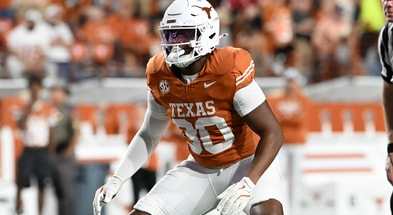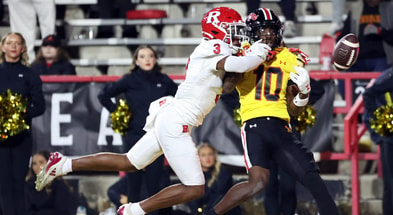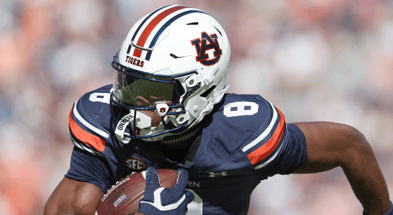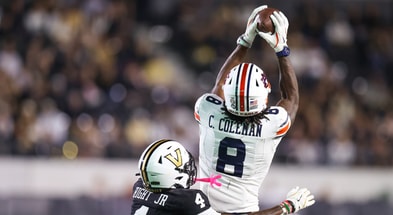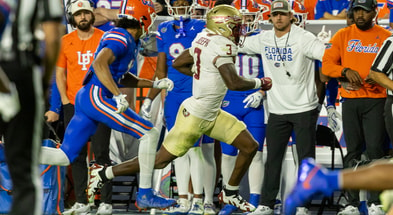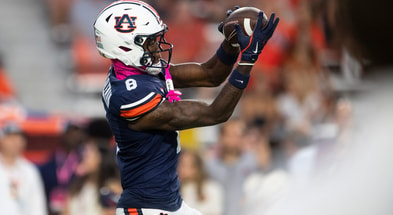What we learned from Texas’ 49-17 win over Florida
In Texas’ commanding victory over Florida, multiple facets of the team performed at a high level, and showed their potential to be a complete and formidable squad. Here’s a closer breakdown of key players and position groups.
[Join Inside Texas TODAY with code HOOKEM and get 50% off annual memberships!]
Quinn Ewers – A Complete Quarterback Performance
Quinn Ewers returned with a strong performance, showing a level of control and confidence reminiscent of his early-season form. After struggling with injuries, he stepped onto the field with noticeable poise and command. His decision-making was efficient and smart; he read the defense well, avoided risky throws, and maintained a consistent rhythm throughout the game, which was crucial for Texas’ offensive flow.
One notable improvement was Ewers’ pocket awareness. He stepped up under pressure a few times, evading defenders to extend plays—a sign of maybe being mentally and physically healthy. Ewers executed Sark’s game plan with precision, elevating the offense and making it difficult for Florida’s defense to anticipate his moves.
Running Game – The Emergence of Jerrick Gibson
Texas’ ground game struggled with the offensive line unable to establish a strong push. However, the game shifted dramatically in the second half when freshman Jerrick Gibson, affectionately nicknamed “Baby Rhino,” received most of the carries. Gibson’s bruising style, power, and energy brought a new spark to the offense. Despite a fumble, the coaches’ decision to trust him to finish the game demonstrated their confidence in his potential. Gibson’s ability to break tackles and wear down defenders helped Texas control the tempo in the latter part of the game, making a big impact on the outcome.
Additionally, Texas’ running backs became a valuable part of the passing game, proving themselves as playmakers in open space. Sark’s classic throwback screen pass to Tre Wisner was executed perfectly, leading to a long touchdown that highlighted Wisner’s speed and field vision. Jaydon Blue also showcased his versatility, contributing after the catch to add a new layer to the offense. The backs’ ability to make plays in space and create mismatches made them valuable assets to Ewers and helped diversify the offensive attack.
Wide Receivers – Playmakers and Game Changers
Isaiah Bond’s return to the lineup was a major boost for the Longhorns. After missing time due to injury, Bond showed why he’s such a vital part of the offense. His versatility was on full display, as he made plays on screen passes, reverses, and the threat of him going deep demands attention getting others open. Bond’s speed and agility make him a unique weapon; he can score from anywhere on the field and poses a constant threat that keeps defenses on their toes.
Matthew Golden continued to be a reliable target, especially in the red zone. His dependable hands and timing with Ewers made him a preferred option near the goal line, where his ability to make tough catches added another layer to Texas’ scoring threats. Gunnar Helm also had a productive day, finding himself wide open for an easy early touchdown, which helped set the tone and establish momentum.
Perhaps the most impressive aspect of the receivers’ performance was their ability to generate yards after the catch. This strength, which had been a hallmark earlier in the season, was on full display as the receivers consistently made defenders miss and turned short gains into big plays. Their knack for creating yards after reception added an explosive dimension to Texas’ passing game, helping them extend drives and control the pace.
Offensive Line – Struggles and Adjustments
The offensive line had a challenging start, particularly in handling stunts and creating running lanes. However, they made key adjustments in the second half, wearing down Florida’s defensive line and opening up lanes for Gibson’s powerful runs. This adjustment was crucial to Texas’ ability to establish control in the latter part of the game, showcasing the line’s resilience and ability to adapt.
In pass protection, the O-line improved as the game progressed, giving Ewers the clean pocket he needed to operate effectively. Their ability to keep Ewers largely untouched allowed him the time to go through his reads, contributing to his overall efficiency and helping the offense maintain a steady rhythm.
Defensive Line – Trey Moore and the Pass Rush
On defense, Trey Moore stood out as a versatile and complete edge player. Moore’s ability to hold the edge against the run, disrupt screens, and rush the quarterback effectively made him a key contributor to Texas’ defensive success. He consistently made plays that kept Florida’s offense off-balance.
Top 10
- 1Breaking
Ty Simpson
Makes decision on future
- 2New
Mark Cuban
Donation to Indiana portal fund
- 3Hot
QB Dominoes
Inside the battle for transfers
- 4
Jackson Arnold
Makes transfer commitment
- 5
Demond Williams
Early schools to watch
Get the Daily On3 Newsletter in your inbox every morning
By clicking "Subscribe to Newsletter", I agree to On3's Privacy Notice, Terms, and use of my personal information described therein.
The rest of the defensive line complemented Moore by maintaining consistent pressure on the Florida quarterback. They applied steady pressure throughout the game, although they occasionally lost lane discipline, which allowed Florida some success with the run in the second half. However, the depth on the D-line allowed for frequent rotations, keeping players fresh and providing younger players with valuable experience.
Linebackers – Speed and Playmaking
Texas’ linebackers showcased a combination of speed, instinct, and aggressiveness that disrupted Florida’s offensive plans. Anthony Hill stood out with his relentless play, flying around to make tackles and forcing a fumble that further swung momentum Texas’ way. His instincts and physical presence made him a key factor in shutting down Florida’s running game.
Freshman Ty’Anthony Smith also made his presence felt with an interception, showcasing his ability to read the quarterback’s eyes and position himself well in coverage. His development speaks to the depth Texas has at linebacker, and his impact alongside Hill added a layer of intensity and versatility to the defensive scheme.
Secondary – Lockdown Coverage
Texas’ secondary was sharp, maintaining tight coverage and communicating well as a unit. They limited Florida’s big plays and kept receivers from finding open space, forcing Florida’s quarterback into difficult throws. Outside of a few completions, the secondary remained disciplined, ensuring that Florida’s passing game couldn’t build any momentum.
This strong secondary performance underscored their ability to anticipate routes and adjust on the fly, further solidifying their impact on Texas’ defensive success.
Special Teams – A Work in Progress
Although Texas demonstrated strength in most phases, special teams continues to be a work in progress. Inconsistent performances and missed opportunities remain a concern, and Texas will need to address this unit if they hope to have a well-rounded performance heading into the playoffs. Improved consistency on special teams could add another layer to Texas’ game, making them even harder to compete against.
Overall Takeaway
This victory demonstrated Texas’ potential when it plays as a complete unit. The Longhorns looked like the team fans expected them to be in the preseason—a balanced, powerful squad capable of dominating in every aspect of the game. If they can sustain this level of performance, Texas will be a formidable opponent heading into the playoffs.
